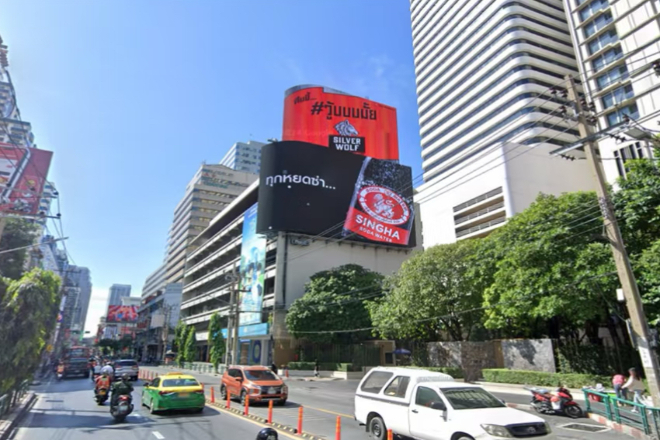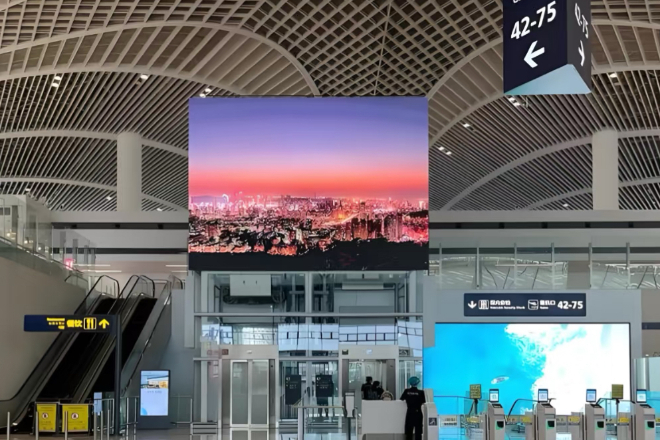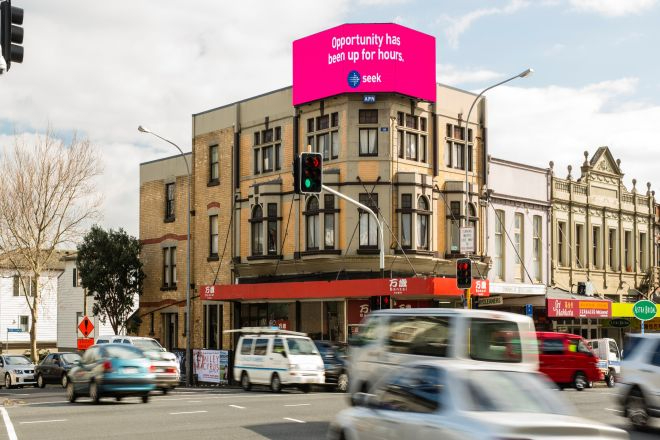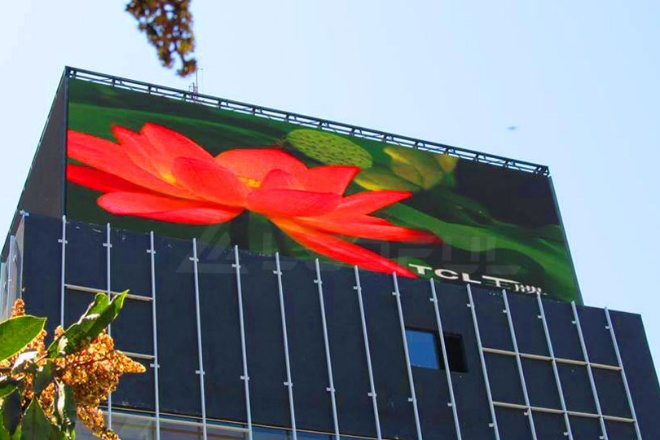Introduction
Does it sound cool to install LED displays on the rooftop? Imagine a huge screen flashing on the top of a tall building, attracting countless eyes no matter day or night.
However, this seemingly perfect installation method actually has its advantages and disadvantages. This article will talk about whether the LED display on the rooftop is worth installing!
Table of Contents
1. What is a rooftop LED display?
As the name suggests, the rooftop LED display is to install the LED display on the highest point of the building – the rooftop. This installation method is a bit like putting a “glowing hat” on the building, making it particularly conspicuous in the city.
Imagine that you are walking on the street, and you can look up and see the shiny big screen on the top of the tall building. Isn’t it easy to attract your attention?
1). Installation method
Installing a rooftop LED display is not a simple matter. Because the environment on the roof is special, it is windy, sunny and rainy, so you have to pay special attention.
First of all, the display must be able to withstand strong winds, otherwise a gust of wind will blow over and the screen will sway.
Therefore, many display screens are designed to be slightly tilted, or the modules are designed with an oblique 8 so that the wind can slip away from the side and reduce the impact on the screen.
Secondly, the space on the roof is limited, and we have to consider whether the building can bear the weight of the display screen. After all, this thing weighs at least several hundred pounds. If the building can’t bear it, it will be troublesome.
Finally, we have to deal with the power supply and signal line problems. The power supply must be stable, and the signal transmission must be clear; otherwise, the screen will either be black or the picture will freeze, which is too embarrassing.
2). Common application scenarios
There are many application scenarios for rooftop LED display screens, which almost cover many places in our lives.

2.1). Advertising screens in commercial centers:
When you go shopping in a mall, look up and see if you can often see a large screen on the roof. It may be playing advertisements of various brands, such as new mobile phones, fashionable clothing, food promotions, etc.
These advertising screens are very useful. They can attract pedestrians and drivers from a distance and attract them to the mall.
For example, if you drive past a commercial center and see an advertisement for a restaurant you are interested in on the rooftop screen, you might stop to try it.
Propaganda screens for landmark buildings:
Every city has its own landmark buildings, such as the Oriental Pearl Tower in Shanghai and the Little Slender Waist in Guangzhou.
If the rooftops of these landmark buildings are equipped with LED screens, they will become a beautiful landscape.
They can display the image promotional videos of the city, such as introducing the beautiful scenery, cultural activities, festivals and celebrations of the city.
For example, during Christmas, the rooftop screen plays a lively picture of Santa Claus, with the background of the Christmas tree, and the whole city is full of festive atmosphere.

2.2). Information screens at transportation hubs:
Airports, railway stations, and bus stations are places with a particularly large flow of people, and information transmission is very important.
Installing LED screens on the rooftops of these transportation hubs can display information such as flights, train numbers, and weather.
For example, at the airport, when passengers get off the plane, they can look up and see the flight information on the rooftop screen, knowing which direction to go or when the next flight will take off, which is very convenient.
2.3). Sports stadium event screen:
During sports events, the atmosphere is particularly warm. Installing an LED display screen on the roof of a sports stadium can broadcast live game scenes, or display scores, player information, etc.
For example, at the critical moment of a football game, the score is displayed in real-time on the roof screen so that the audience outside the stadium can also feel the tension and passion of the game.
2.4). Brand promotion screen in the corporate headquarters building:
In order to showcase their brand image, many companies will install LED displays on the roof of their headquarters building.
For example, some large companies will display their logos, brand slogans or corporate culture on the screen. In this way, passers-by can see it at a glance, and the impression of the corporate brand will be deeper.
2. Advantages of installing LED displays on the rooftop

If you install an LED display screen on the rooftop, it is really “standing high and seeing far”.
Just think about it, when you walk on the street, you can look up and see the big screen on the top of a tall building in the distance. How conspicuous it is!
The advantages of this location are too obvious. Whether you are a pedestrian on the road, a driver passing by, or even someone working in the opposite building, you can easily see the content on the screen.
It’s like giving the advertisement wings so that it can fly farther and attract more viewers.
Moreover, the screen on the roof is not only useful during the day. At night, when it lights up, it is like a night pearl, illuminating the surroundings.
This 24-hour uninterrupted display allows the spread of advertisements or information to last longer, and the effect is naturally better.
For example, a newly opened restaurant advertises on the rooftop screen. People passing by during the day may go in and try it, and people driving home at night may also be attracted to it. This high visibility is simply a “super accelerator” for advertising!
Another great thing about the rooftop LED display is that it is particularly “sensible” and does not take up space.
Think about it, many billboards are either placed on the roadside or in shopping malls, taking up a lot of valuable space.
But the screen on the rooftop is different. It stays quietly on the rooftop and does not disturb the normal life and work below. This is so important in the city, especially in those places where every inch of land is valuable.
Moreover, the rooftop is often idle and useless. But after installing the LED display, this “wasteland” becomes a super valuable advertising space.
It’s like planting flowers on your balcony, which not only beautifies the environment but also makes the idle space useful.
For businesses or landlords, this is an extra income, and there is no need to sacrifice the space inside the building. It is simply a good way to “make money while lying down.”
The viewing angle effect of the LED display on the top floor is also superb. It is not the kind of screen that “selects people to watch”. No matter which angle you look at it from, you can see a clear picture.
This is the so-called “wide viewing angle”. The design of the screen allows it to be viewed from the front, side, or even slightly tilted. The content is clear and not blurry at all.
This design has many benefits. First, it can attract more viewers because no matter where you are, you will not miss the wonderful content on the screen.
Secondly, the visual impact of this screen is particularly strong. Imagine that you see a huge screen in the distance, playing wonderful content on it, and the shocking feeling comes to you all at once.
This unique perspective effect not only attracts the audience’s attention but also makes it easier for them to remember the content on the screen, and the advertising effect will naturally increase.
Another particularly powerful feature of the rooftop LED display is that it can be perfectly integrated with the building. You can think of it as a “new hat” for the building, which is not only beautiful, but also matches the overall style of the building.
For example, if the building is a modern design, the screen can be designed in a simple and generous style; if it is a retro-style building, the screen can also be matched with special shapes and colors.
Moreover, a good design can make the screen the highlight of the building. At night, when the screen lights up, the entire building will become sparkling and particularly stylish.
For some commercial centers, landmark buildings or corporate headquarters, this integration can not only display advertising content but also enhance the appearance of the building, making it stand out in the city and become a beautiful landscape.
For example, the headquarters building of a technology company installed a highly designed LED screen on the top floor, which not only displays the company’s brand image but also makes the entire building look full of technology, which instantly enhances the company’s image.
For enterprises, the rooftop LED display is simply a “secret weapon” to enhance the brand image.
Think about it, when you see a company install a super large screen on the top of a tall building, displaying exquisite advertisements and brand images, do you think this company is particularly powerful?
This high-end display method can not only attract people’s attention, but also convey the strength and taste of the company.
In addition, the content of the LED display can be updated at any time, and the company can quickly adjust the display content according to different activities or market changes.
For example, a clothing brand can display new product advertisements when the season changes, or display discount information during promotional activities.
This flexible and changeable display method allows companies to always maintain freshness and attract more customers.
More importantly, through this method, companies can better convey their brand concepts and values, so that customers have a deeper impression of the company, thereby enhancing the brand’s popularity and reputation.
In short, the rooftop LED display can not only spread advertisements and information further but also make buildings and companies more eye-catching. This is really a good thing that “kills two birds with one stone”!
3. Can LED screens be installed on all roofs?
Not all roofs can be installed with LED screens.
Many people think that if they want to install an LED screen on the roof, they just need to find a worker to install it.
In fact, it is not that simple! Before installing an LED screen, you have to think about it carefully. Otherwise, you may encounter a lot of trouble.
The following are some key points to help you figure out why not all roofs can be installed with LED screens.
First of all, you have to see if the roof can “bear” the weight of the screen. The LED screen is not light.
It weighs at least hundreds of pounds, or even thousands of pounds, with brackets, equipment, etc.
If the load-bearing capacity of the roof is not enough, it will be dangerous, and it may collapse the roof or cause structural damage.
Therefore, before installation, you have to find a professional construction engineer to evaluate the load-bearing capacity of the roof to see if it can withstand the weight of the screen.
Secondly, the wind on the roof is particularly strong, and the screen must be able to “bear” the wind. Think about it: the wind blows on the roof.
If the display screen is not strong, a strong wind may blow it all over the place or even blow it down, which is too dangerous.
Therefore, the bracket of the display screen must be designed to be particularly strong, and some special designs are usually adopted, such as tilt angle or 8° tilt design, so that the wind can slip away from the side and reduce the pressure of the wind on the display screen.
You can’t install LED display screens whenever you want. You must comply with local laws and regulations. Many cities have strict regulations on rooftop advertising facilities.
For example, some places stipulate that large outdoor LED display screens with commercial content cannot be installed on educational and scientific research land and residential land because this may interfere with the lives of residents or affect the overall planning of the city.
Some places also require the installation of outdoor display screens to comply with relevant regulations on high-altitude operations in construction.
Moreover, before installing an LED display screen, you must apply for an installation permit from the relevant department. If you install it secretly without a permit, it will be troublesome.
You may be fined or even required to remove it. Therefore, before installation, you must consult the local urban management, planning department or relevant agencies to see if your roof can be equipped with an LED display and what procedures are required.
The environment on the roof is relatively harsh, and the display must be able to “withstand” wind and rain. First, it must be waterproof.
It often rains on the roof, and if the display is not waterproof, it is easy to be damaged. Therefore, the shell of the display must have a waterproof design, and it is necessary to regularly check whether the waterproof strip is aging.
Secondly, it must be lightning-proof. The roof is a high-risk area for lightning strikes. If the display is struck by lightning, it will be completely useless.
Therefore, when installing the display, a lightning protection grounding device must be installed to lead the lightning underground to protect the display.
In addition, the problem of light pollution must also be considered. The brightness of the LED display is very high.
If the brightness is not well controlled, it may cause interference to surrounding residents or traffic.
For example, if the screen is too bright at night, it may shine into the homes of residents opposite and affect their rest.
Therefore, the display must have a brightness adjustment function to automatically adjust the brightness according to different time periods and ambient light.
Installing an LED display is not just about finding a place to install it. You also have to consider the visual effect. First of all, the display must be coordinated with the overall style of the building.
Just think about it: if the building is retro-style, but you install a particularly modern and fancy display, how abrupt would it be?
Therefore, the design of the display must match the style of the building, such as color, shape, material, etc.
Secondly, the viewing angle of the display is also very important. You have to make sure that you can see a clear picture from different angles.
For example, the picture cannot be blurred or distorted when viewed from a distance, from the side, or from the road downstairs. Moreover, the location of the display is also critical. It must be visible to passers-by at a glance, but it must not affect the traffic line of sight.
Installing an LED display is not a cheap thing. You have to consider the cost.
First of all, the installation cost is very high. You have to hire a professional installation team and buy high-quality displays and brackets.
Moreover, during the installation process, you have to consider the layout of power cables and signal cables, which require additional costs.
Secondly, the maintenance cost is not low. The display screen is installed on the roof, which is very troublesome to maintain. You have to check the fixing of the display screen regularly to see if it is loose.
You also have to check the waterproof and dustproof performance to see if there is any damage. If there is a malfunction, you have to ask professionals to repair it, which costs money.
4. Precautions for installing LED display screens on the rooftop

1). Consult professionals in advance
Before installing LED display screens on the rooftop, be sure to find professional construction engineers and installation teams to evaluate.
They can help you check the load-bearing capacity of the roof to see if it can bear the weight of the display screen.
If the roof is not load-bearing enough, forced installation may collapse the roof, which will be a big trouble.
At the same time, the professional team can also help you design a reasonable installation plan to ensure that the display screen is both firm and beautiful after installation.
2). Handle relevant procedures
Installing LED display screens is not something you can do whenever you want.
You must first consult the local urban management, planning department or relevant agencies to see if your rooftop can be installed with a display screen and what procedures are required.
If you install it secretly without a license, you may be fined or even asked to remove it. Therefore, you must follow the formal process and apply for installation permission to avoid unnecessary trouble.
3). Consider waterproofing and lightning protection measures
The environment on the roof is relatively harsh and is often exposed to wind and rain, so waterproofing and lightning protection measures must be in place.
The outer shell of the display screen must have a waterproof design, and you must regularly check whether the waterproof strips are aging.
If the waterproof measures are not in place, the display screen can be easily damaged by water.
In addition, the roof is a high-risk area for lightning strikes, so a lightning protection grounding device must be installed to lead lightning to the ground to protect the display screen.
4). Pay attention to safety during the installation process
When installing the LED display screen, safety cannot be ignored.
The roof is relatively high, and there may be a risk of falling from a high altitude during the installation process. Therefore, the installer must wear a safety belt and take protective measures.
At the same time, the installation equipment must be firm and reliable and cannot be sloppy. If a safety accident occurs during the installation process, it will be more trouble than gain.
5). Consider the surrounding environment and residents’ feelings
When installing the LED display screen, you must also consider the surrounding environment and residents’ feelings.
For example, the content of the display screen cannot be too dazzling or flickering so as not to affect the lives of surrounding residents; the installation location cannot affect the lighting or ventilation of surrounding buildings.
If the surrounding residents have opinions on the display screen, communicate and resolve them in time to avoid conflicts.
5. Conclusion
In short, although there are many benefits to installing an LED display screen on the roof, you must also consider various restrictions and costs.
If conditions permit, it will definitely make your building or advertising effect “shine”. However, be sure to plan ahead; don’t regret it later!
Finally, if you want to know more about LED displays, please get in touch with us.
